Attached files
| file | filename |
|---|---|
| 8-K - 8-K - Equillium, Inc. | d634018d8k.htm |
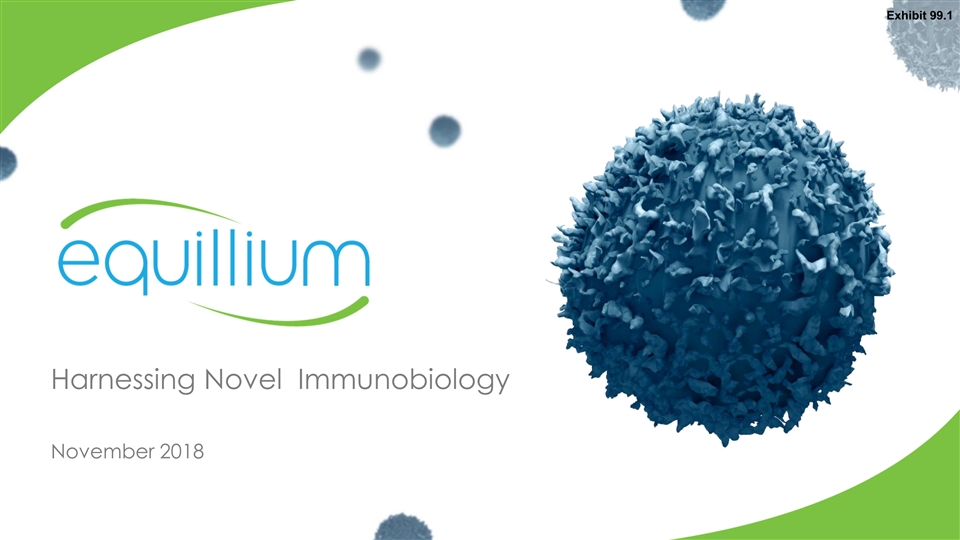
Exhibit 99.1 Harnessing Novel Immunobiology November 2018Exhibit 99.1 Harnessing Novel Immunobiology November 2018
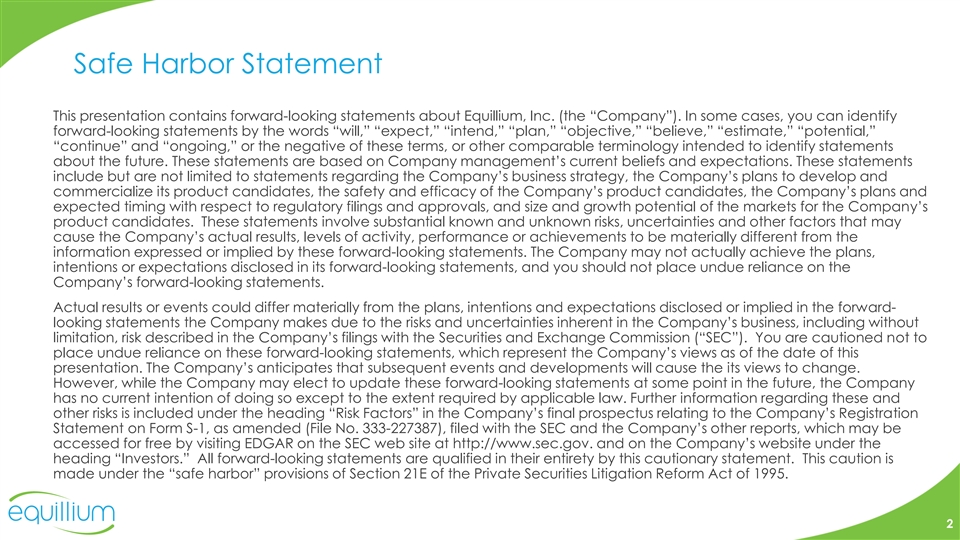
Safe Harbor Statement This presentation contains forward-looking statements about Equillium, Inc. (the “Company”). In some cases, you can identify forward-looking statements by the words “will,” “expect,” “intend,” “plan,” “objective,” “believe,” “estimate,” “potential,” “continue” and “ongoing,” or the negative of these terms, or other comparable terminology intended to identify statements about the future. These statements are based on Company management’s current beliefs and expectations. These statements include but are not limited to statements regarding the Company’s business strategy, the Company’s plans to develop and commercialize its product candidates, the safety and efficacy of the Company’s product candidates, the Company’s plans and expected timing with respect to regulatory filings and approvals, and size and growth potential of the markets for the Company’s product candidates. These statements involve substantial known and unknown risks, uncertainties and other factors that may cause the Company’s actual results, levels of activity, performance or achievements to be materially different from the information expressed or implied by these forward-looking statements. The Company may not actually achieve the plans, intentions or expectations disclosed in its forward-looking statements, and you should not place undue reliance on the Company’s forward-looking statements. Actual results or events could differ materially from the plans, intentions and expectations disclosed or implied in the forward- looking statements the Company makes due to the risks and uncertainties inherent in the Company’s business, including without limitation, risk described in the Company’s filings with the Securities and Exchange Commission (“SEC”). You are cautioned not to place undue reliance on these forward-looking statements, which represent the Company’s views as of the date of this presentation. The Company’s anticipates that subsequent events and developments will cause the its views to change. However, while the Company may elect to update these forward-looking statements at some point in the future, the Company has no current intention of doing so except to the extent required by applicable law. Further information regarding these and other risks is included under the heading “Risk Factors” in the Company’s final prospectus relating to the Company’s Registration Statement on Form S-1, as amended (File No. 333-227387), filed with the SEC and the Company’s other reports, which may be accessed for free by visiting EDGAR on the SEC web site at http://www.sec.gov. and on the Company’s website under the heading “Investors.” All forward-looking statements are qualified in their entirety by this cautionary statement. This caution is made under the “safe harbor” provisions of Section 21E of the Private Securities Litigation Reform Act of 1995. 2Safe Harbor Statement This presentation contains forward-looking statements about Equillium, Inc. (the “Company”). In some cases, you can identify forward-looking statements by the words “will,” “expect,” “intend,” “plan,” “objective,” “believe,” “estimate,” “potential,” “continue” and “ongoing,” or the negative of these terms, or other comparable terminology intended to identify statements about the future. These statements are based on Company management’s current beliefs and expectations. These statements include but are not limited to statements regarding the Company’s business strategy, the Company’s plans to develop and commercialize its product candidates, the safety and efficacy of the Company’s product candidates, the Company’s plans and expected timing with respect to regulatory filings and approvals, and size and growth potential of the markets for the Company’s product candidates. These statements involve substantial known and unknown risks, uncertainties and other factors that may cause the Company’s actual results, levels of activity, performance or achievements to be materially different from the information expressed or implied by these forward-looking statements. The Company may not actually achieve the plans, intentions or expectations disclosed in its forward-looking statements, and you should not place undue reliance on the Company’s forward-looking statements. Actual results or events could differ materially from the plans, intentions and expectations disclosed or implied in the forward- looking statements the Company makes due to the risks and uncertainties inherent in the Company’s business, including without limitation, risk described in the Company’s filings with the Securities and Exchange Commission (“SEC”). You are cautioned not to place undue reliance on these forward-looking statements, which represent the Company’s views as of the date of this presentation. The Company’s anticipates that subsequent events and developments will cause the its views to change. However, while the Company may elect to update these forward-looking statements at some point in the future, the Company has no current intention of doing so except to the extent required by applicable law. Further information regarding these and other risks is included under the heading “Risk Factors” in the Company’s final prospectus relating to the Company’s Registration Statement on Form S-1, as amended (File No. 333-227387), filed with the SEC and the Company’s other reports, which may be accessed for free by visiting EDGAR on the SEC web site at http://www.sec.gov. and on the Company’s website under the heading “Investors.” All forward-looking statements are qualified in their entirety by this cautionary statement. This caution is made under the “safe harbor” provisions of Section 21E of the Private Securities Litigation Reform Act of 1995. 2
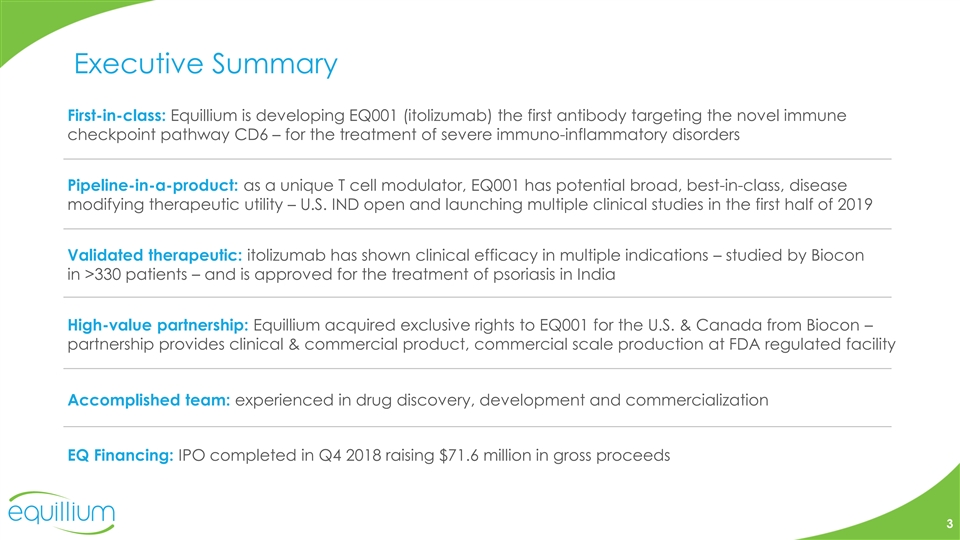
Executive Summary First-in-class: Equillium is developing EQ001 (itolizumab) the first antibody targeting the novel immune checkpoint pathway CD6 – for the treatment of severe immuno-inflammatory disorders Pipeline-in-a-product: as a unique T cell modulator, EQ001 has potential broad, best-in-class, disease modifying therapeutic utility – U.S. IND open and launching multiple clinical studies in the first half of 2019 Validated therapeutic: itolizumab has shown clinical efficacy in multiple indications – studied by Biocon in >330 patients – and is approved for the treatment of psoriasis in India High-value partnership: Equillium acquired exclusive rights to EQ001 for the U.S. & Canada from Biocon – partnership provides clinical & commercial product, commercial scale production at FDA regulated facility Accomplished team: experienced in drug discovery, development and commercialization EQ Financing: IPO completed in Q4 2018 raising $71.6 million in gross proceeds 3Executive Summary First-in-class: Equillium is developing EQ001 (itolizumab) the first antibody targeting the novel immune checkpoint pathway CD6 – for the treatment of severe immuno-inflammatory disorders Pipeline-in-a-product: as a unique T cell modulator, EQ001 has potential broad, best-in-class, disease modifying therapeutic utility – U.S. IND open and launching multiple clinical studies in the first half of 2019 Validated therapeutic: itolizumab has shown clinical efficacy in multiple indications – studied by Biocon in >330 patients – and is approved for the treatment of psoriasis in India High-value partnership: Equillium acquired exclusive rights to EQ001 for the U.S. & Canada from Biocon – partnership provides clinical & commercial product, commercial scale production at FDA regulated facility Accomplished team: experienced in drug discovery, development and commercialization EQ Financing: IPO completed in Q4 2018 raising $71.6 million in gross proceeds 3
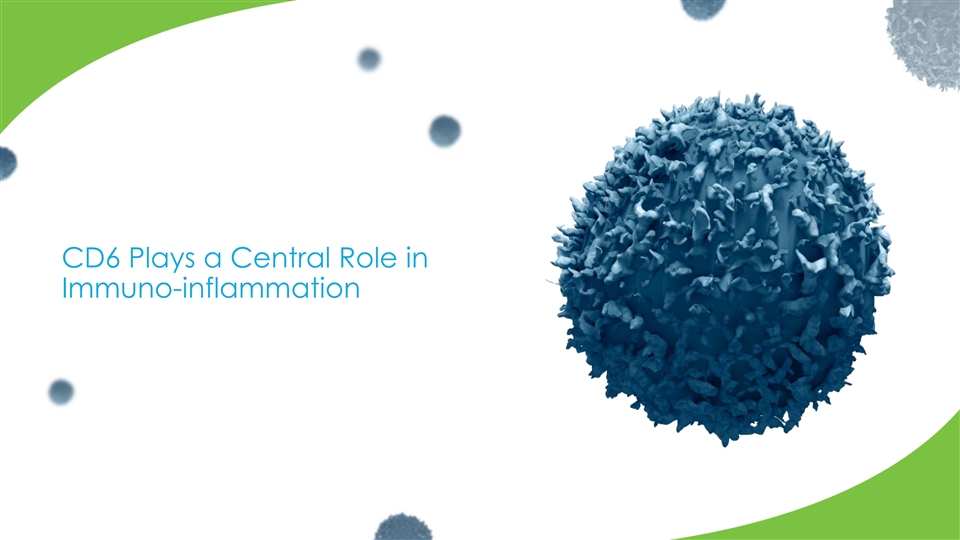
CD6 Plays a Central Role in Immuno-inflammationCD6 Plays a Central Role in Immuno-inflammation
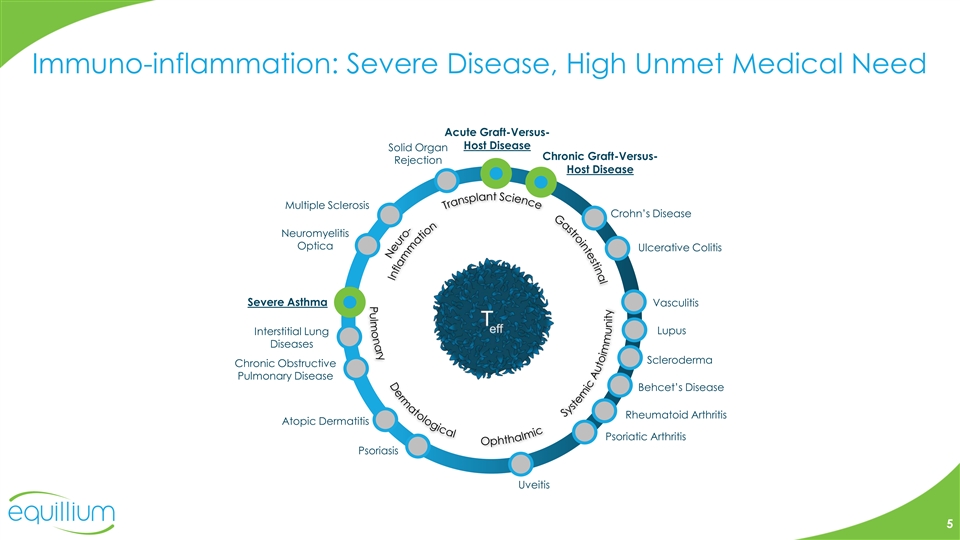
Immuno-inflammation: Severe Disease, High Unmet Medical Need Acute Graft-Versus- Host Disease Solid Organ Chronic Graft-Versus- Rejection Host Disease Multiple Sclerosis Crohn’s Disease Neuromyelitis Optica Ulcerative Colitis Severe Asthma Vasculitis Lupus Interstitial Lung Diseases Scleroderma Chronic Obstructive Pulmonary Disease Behcet’s Disease Rheumatoid Arthritis Atopic Dermatitis Psoriatic Arthritis Psoriasis Uveitis 5Immuno-inflammation: Severe Disease, High Unmet Medical Need Acute Graft-Versus- Host Disease Solid Organ Chronic Graft-Versus- Rejection Host Disease Multiple Sclerosis Crohn’s Disease Neuromyelitis Optica Ulcerative Colitis Severe Asthma Vasculitis Lupus Interstitial Lung Diseases Scleroderma Chronic Obstructive Pulmonary Disease Behcet’s Disease Rheumatoid Arthritis Atopic Dermatitis Psoriatic Arthritis Psoriasis Uveitis 5
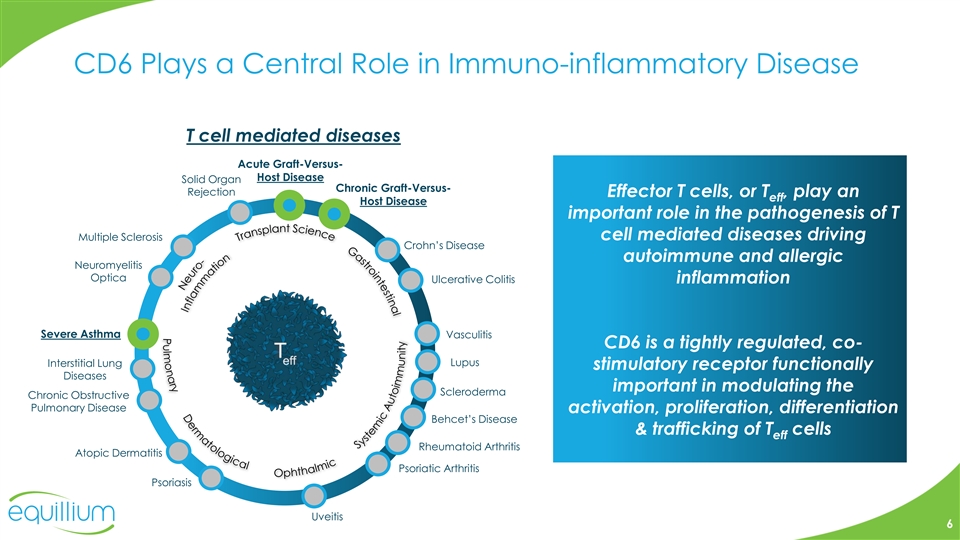
CD6 Plays a Central Role in Immuno-inflammatory Disease T cell mediated diseases Acute Graft-Versus- Host Disease Solid Organ Chronic Graft-Versus- Rejection Effector T cells, or T , play an eff Host Disease important role in the pathogenesis of T cell mediated diseases driving Multiple Sclerosis Crohn’s Disease autoimmune and allergic Neuromyelitis Optica Ulcerative Colitis inflammation Severe Asthma Vasculitis CD6 is a tightly regulated, co- Lupus Interstitial Lung stimulatory receptor functionally Diseases important in modulating the Scleroderma Chronic Obstructive Pulmonary Disease activation, proliferation, differentiation Behcet’s Disease & trafficking of T cells eff Rheumatoid Arthritis Atopic Dermatitis Psoriatic Arthritis Psoriasis Uveitis 6CD6 Plays a Central Role in Immuno-inflammatory Disease T cell mediated diseases Acute Graft-Versus- Host Disease Solid Organ Chronic Graft-Versus- Rejection Effector T cells, or T , play an eff Host Disease important role in the pathogenesis of T cell mediated diseases driving Multiple Sclerosis Crohn’s Disease autoimmune and allergic Neuromyelitis Optica Ulcerative Colitis inflammation Severe Asthma Vasculitis CD6 is a tightly regulated, co- Lupus Interstitial Lung stimulatory receptor functionally Diseases important in modulating the Scleroderma Chronic Obstructive Pulmonary Disease activation, proliferation, differentiation Behcet’s Disease & trafficking of T cells eff Rheumatoid Arthritis Atopic Dermatitis Psoriatic Arthritis Psoriasis Uveitis 6
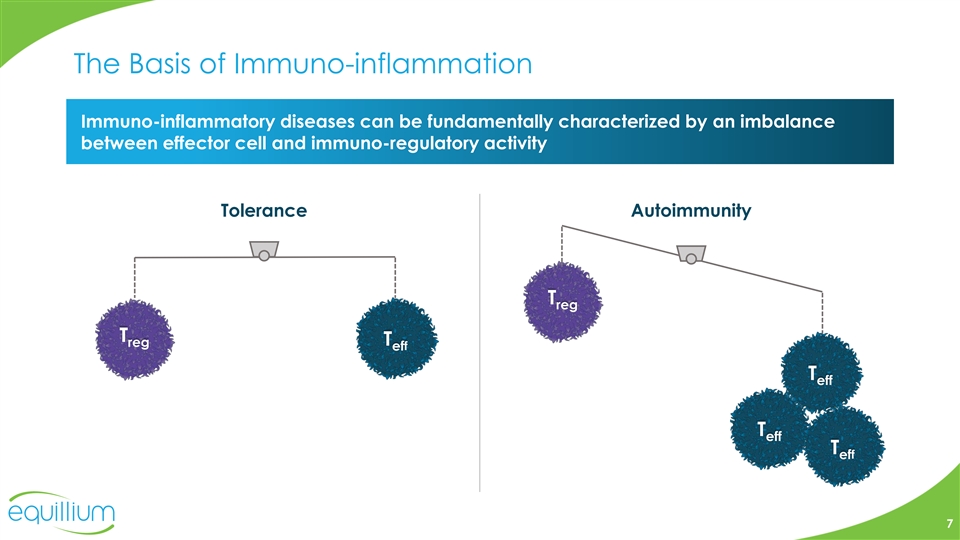
The Basis of Immuno-inflammation Immuno-inflammatory diseases can be fundamentally characterized by an imbalance between effector cell and immuno-regulatory activity Tolerance Autoimmunity T reg T T reg f ef T eff T eff T eff 7The Basis of Immuno-inflammation Immuno-inflammatory diseases can be fundamentally characterized by an imbalance between effector cell and immuno-regulatory activity Tolerance Autoimmunity T reg T T reg f ef T eff T eff T eff 7

CD6 is Central to Immuno-inflammation Highest levels of CD6 are found on activated T effector cells (T ) and associated with eff amplification of the auto-reactive cascade Low/- CD6 CD6 + CD6 Hi T 1 h T 2 h T 17 h CD6 Immune Regulatory Autoreactive “Tolerance”“Autoimmunity” 8CD6 is Central to Immuno-inflammation Highest levels of CD6 are found on activated T effector cells (T ) and associated with eff amplification of the auto-reactive cascade Low/- CD6 CD6 + CD6 Hi T 1 h T 2 h T 17 h CD6 Immune Regulatory Autoreactive “Tolerance”“Autoimmunity” 8

CD6 Drives Pathogenic T Cell Activity & Trafficking Co-stimulation = Activation Proliferation Differentiation / Survival Trafficking Suppression of regulatory pathways 9CD6 Drives Pathogenic T Cell Activity & Trafficking Co-stimulation = Activation Proliferation Differentiation / Survival Trafficking Suppression of regulatory pathways 9
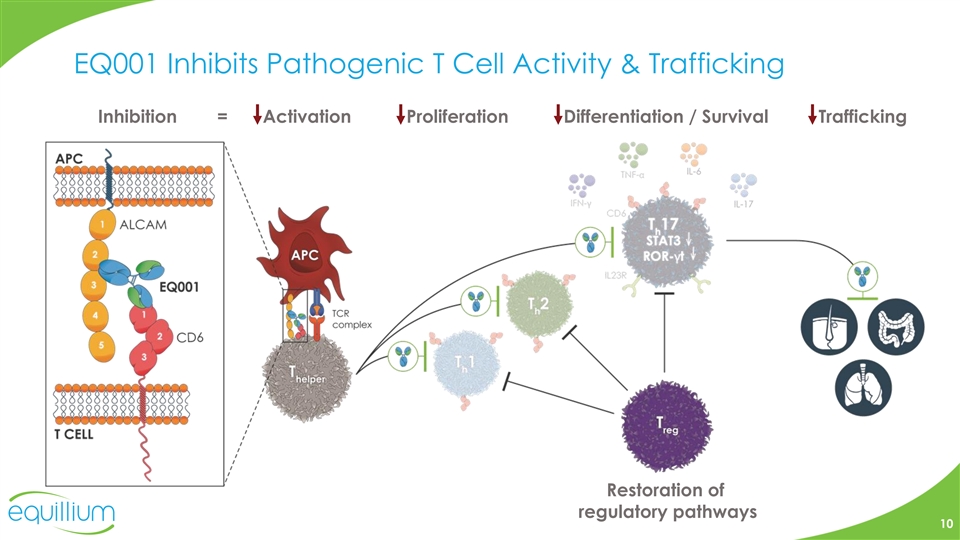
EQ001 Inhibits Pathogenic T Cell Activity & Trafficking Inhibition = Activation Proliferation Differentiation / Survival Trafficking Restoration of regulatory pathways 10EQ001 Inhibits Pathogenic T Cell Activity & Trafficking Inhibition = Activation Proliferation Differentiation / Survival Trafficking Restoration of regulatory pathways 10
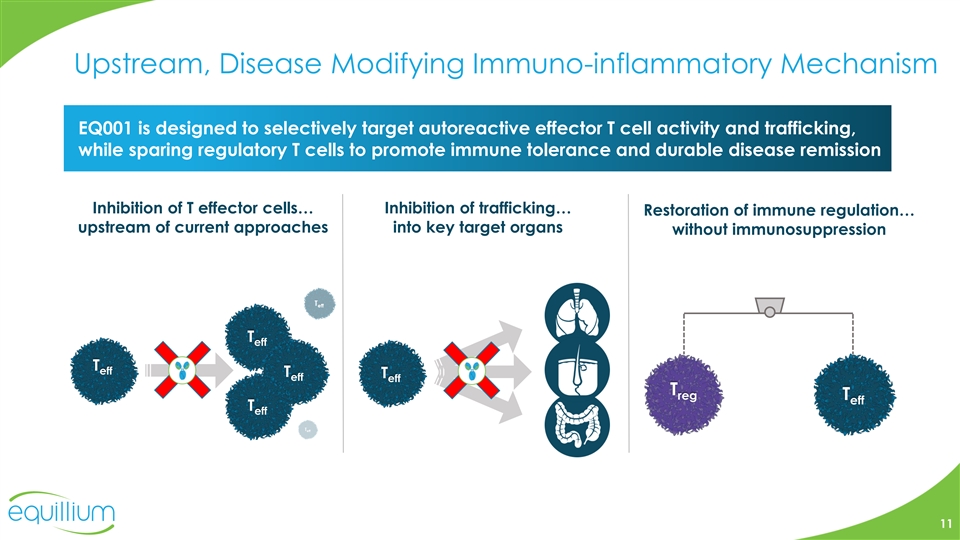
Upstream, Disease Modifying Immuno-inflammatory Mechanism EQ001 is designed to selectively target autoreactive effector T cell activity and trafficking, while sparing regulatory T cells to promote immune tolerance and durable disease remission Inhibition of T effector cells… Inhibition of trafficking… Restoration of immune regulation… upstream of current approaches into key target organs without immunosuppression T eff T eff T T eff eff T reg T eff T eff 11Upstream, Disease Modifying Immuno-inflammatory Mechanism EQ001 is designed to selectively target autoreactive effector T cell activity and trafficking, while sparing regulatory T cells to promote immune tolerance and durable disease remission Inhibition of T effector cells… Inhibition of trafficking… Restoration of immune regulation… upstream of current approaches into key target organs without immunosuppression T eff T eff T T eff eff T reg T eff T eff 11
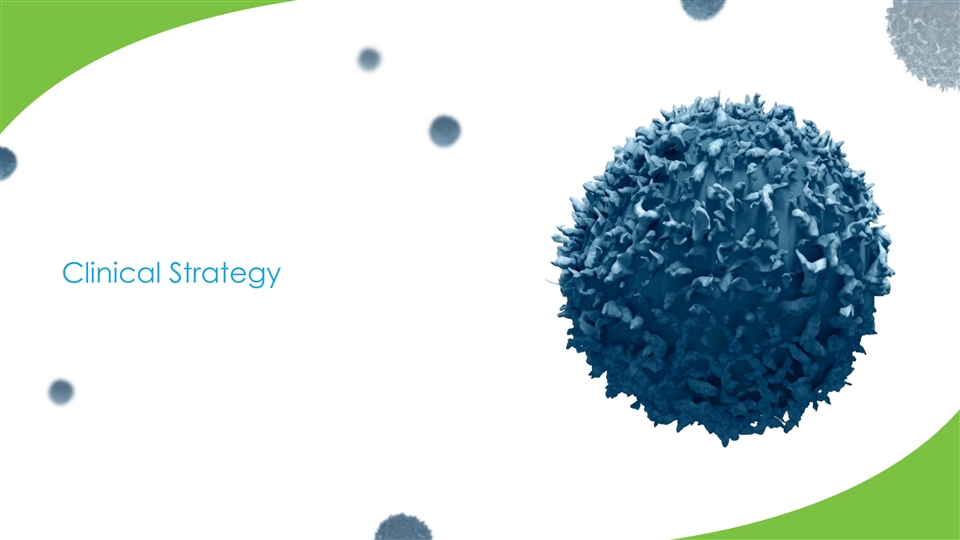
Clinical StrategyClinical Strategy
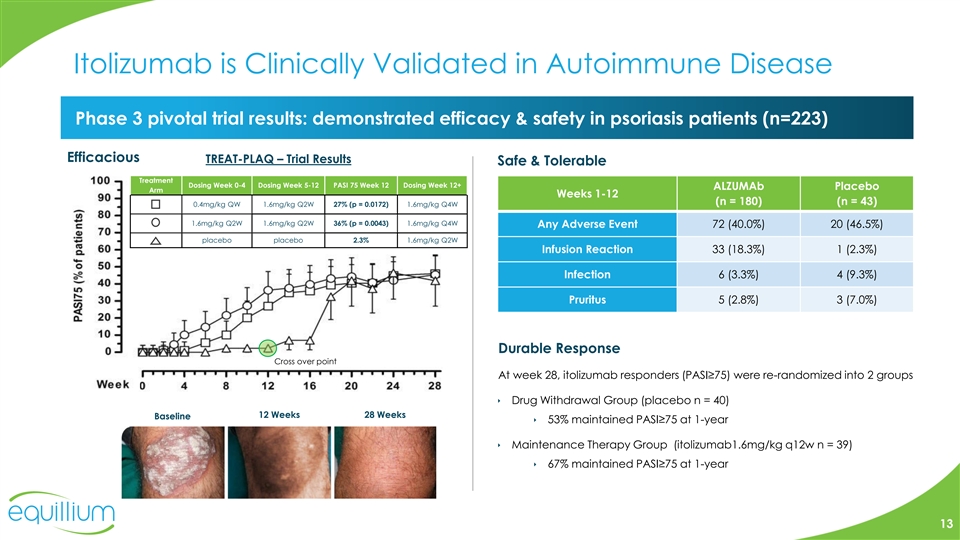
Itolizumab is Clinically Validated in Autoimmune Disease Phase 3 pivotal trial results: demonstrated efficacy & safety in psoriasis patients (n=223) Efficacious TREAT-PLAQ – Trial Results Safe & Tolerable Treatment Dosing Week 0-4 Dosing Week 5-12 PASI 75 Week 12 Dosing Week 12+ ALZUMAb Placebo Arm Weeks 1-12 (n = 180) (n = 43) 0.4mg/kg QW 1.6mg/kg Q2W 27% (p = 0.0172) 1.6mg/kg Q4W 1.6mg/kg Q2W 1.6mg/kg Q2W 36% (p = 0.0043) 1.6mg/kg Q4W Any Adverse Event 72 (40.0%) 20 (46.5%) placebo placebo 2.3% 1.6mg/kg Q2W Infusion Reaction 33 (18.3%) 1 (2.3%) Infection 6 (3.3%) 4 (9.3%) Pruritus 5 (2.8%) 3 (7.0%) Durable Response Cross over point At week 28, itolizumab responders (PASI≥75) were re-randomized into 2 groups ê Drug Withdrawal Group (placebo n = 40) 12 Weeks 28 Weeks Baseline ê 53% maintained PASI≥75 at 1-year ê Maintenance Therapy Group (itolizumab1.6mg/kg q12w n = 39) ê 67% maintained PASI≥75 at 1-year 13Itolizumab is Clinically Validated in Autoimmune Disease Phase 3 pivotal trial results: demonstrated efficacy & safety in psoriasis patients (n=223) Efficacious TREAT-PLAQ – Trial Results Safe & Tolerable Treatment Dosing Week 0-4 Dosing Week 5-12 PASI 75 Week 12 Dosing Week 12+ ALZUMAb Placebo Arm Weeks 1-12 (n = 180) (n = 43) 0.4mg/kg QW 1.6mg/kg Q2W 27% (p = 0.0172) 1.6mg/kg Q4W 1.6mg/kg Q2W 1.6mg/kg Q2W 36% (p = 0.0043) 1.6mg/kg Q4W Any Adverse Event 72 (40.0%) 20 (46.5%) placebo placebo 2.3% 1.6mg/kg Q2W Infusion Reaction 33 (18.3%) 1 (2.3%) Infection 6 (3.3%) 4 (9.3%) Pruritus 5 (2.8%) 3 (7.0%) Durable Response Cross over point At week 28, itolizumab responders (PASI≥75) were re-randomized into 2 groups ê Drug Withdrawal Group (placebo n = 40) 12 Weeks 28 Weeks Baseline ê 53% maintained PASI≥75 at 1-year ê Maintenance Therapy Group (itolizumab1.6mg/kg q12w n = 39) ê 67% maintained PASI≥75 at 1-year 13
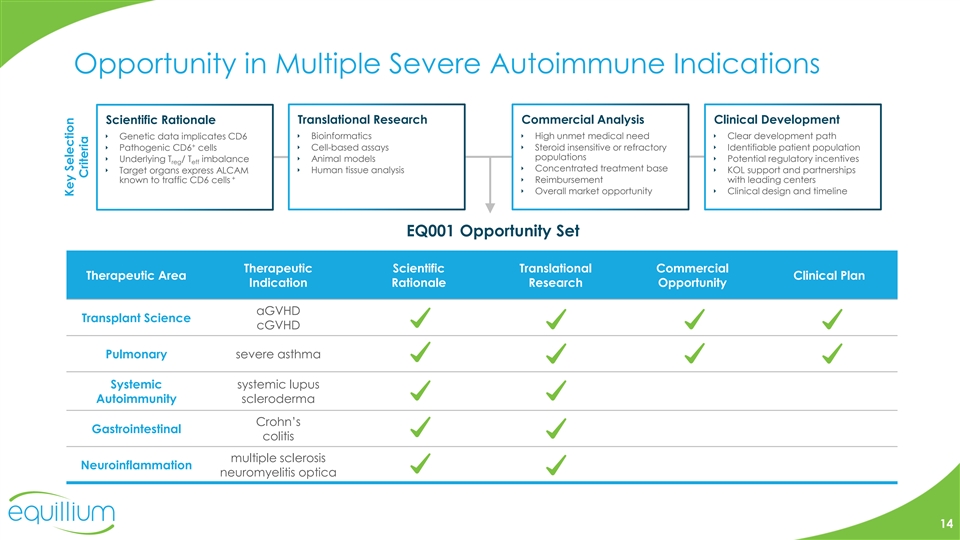
Opportunity in Multiple Severe Autoimmune Indications Scientific Rationale Translational Research Commercial Analysis Clinical Development ê Genetic data implicates CD6ê Bioinformaticsê High unmet medical needê Clear development path + ê Pathogenic CD6 cells ê Cell-based assaysê Steroid insensitive or refractory ê Identifiable patient population populations ê Underlying T / T imbalanceê Animal modelsê Potential regulatory incentives reg eff ê Concentrated treatment base ê Human tissue analysis ê KOL support and partnerships ê Target organs express ALCAM + known to traffic CD6 cellsê Reimbursement with leading centers ê Overall market opportunityê Clinical design and timeline EQ001 Opportunity Set Therapeutic Scientific Translational Commercial Therapeutic Area Clinical Plan Indication Rationale Research Opportunity aGVHD Transplant Science cGVHD Pulmonary severe asthma Systemic systemic lupus Autoimmunity scleroderma Crohn’s Gastrointestinal colitis multiple sclerosis Neuroinflammation neuromyelitis optica 14 Key Selection CriteriaOpportunity in Multiple Severe Autoimmune Indications Scientific Rationale Translational Research Commercial Analysis Clinical Development ê Genetic data implicates CD6ê Bioinformaticsê High unmet medical needê Clear development path + ê Pathogenic CD6 cells ê Cell-based assaysê Steroid insensitive or refractory ê Identifiable patient population populations ê Underlying T / T imbalanceê Animal modelsê Potential regulatory incentives reg eff ê Concentrated treatment base ê Human tissue analysis ê KOL support and partnerships ê Target organs express ALCAM + known to traffic CD6 cellsê Reimbursement with leading centers ê Overall market opportunityê Clinical design and timeline EQ001 Opportunity Set Therapeutic Scientific Translational Commercial Therapeutic Area Clinical Plan Indication Rationale Research Opportunity aGVHD Transplant Science cGVHD Pulmonary severe asthma Systemic systemic lupus Autoimmunity scleroderma Crohn’s Gastrointestinal colitis multiple sclerosis Neuroinflammation neuromyelitis optica 14 Key Selection Criteria
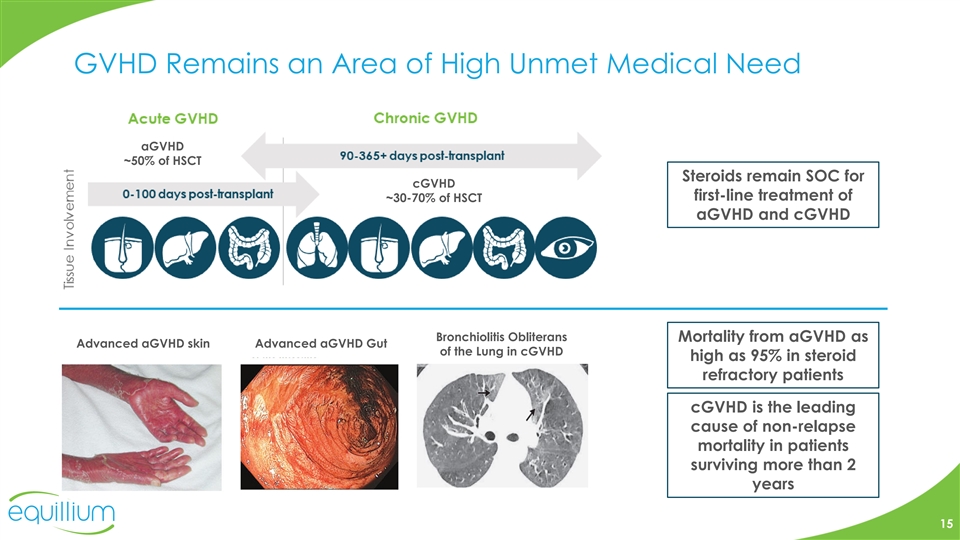
GVHD Remains an Area of High Unmet Medical Need aGVHD ~50% of HSCT Steroids remain SOC for cGVHD first-line treatment of ~30-70% of HSCT aGVHD and cGVHD Bronchiolitis Obliterans Mortality from aGVHD as Advanced aGVHD skin Advanced aGVHD Gut of the Lung in cGVHD high as 95% in steroid refractory patients cGVHD is the leading cause of non-relapse mortality in patients surviving more than 2 years 15GVHD Remains an Area of High Unmet Medical Need aGVHD ~50% of HSCT Steroids remain SOC for cGVHD first-line treatment of ~30-70% of HSCT aGVHD and cGVHD Bronchiolitis Obliterans Mortality from aGVHD as Advanced aGVHD skin Advanced aGVHD Gut of the Lung in cGVHD high as 95% in steroid refractory patients cGVHD is the leading cause of non-relapse mortality in patients surviving more than 2 years 15

GVHD is a Significant & Growing Market Opportunity Projected US aGVHD incidence and GVHD prevalence by the year 2025 Ø Annual incidence of aGVHD up to 6,000 Ø Total prevalence of GVHD up to 35,000 Currently, limited available FDA approved therapies Ø Significant need for safe and effective therapies Ø No products approved for aGVHD Ø Ibrutinib approved 2nd/3rd line for More than 8,500 allogeneic transplants in 2016 cGVHD 4% annual growth rate since 2007 16GVHD is a Significant & Growing Market Opportunity Projected US aGVHD incidence and GVHD prevalence by the year 2025 Ø Annual incidence of aGVHD up to 6,000 Ø Total prevalence of GVHD up to 35,000 Currently, limited available FDA approved therapies Ø Significant need for safe and effective therapies Ø No products approved for aGVHD Ø Ibrutinib approved 2nd/3rd line for More than 8,500 allogeneic transplants in 2016 cGVHD 4% annual growth rate since 2007 16

CD6 Plays a Central Role in GVHD Ø Autoreactive T cells drive tissue damage in GVHD eff Ø T cells overexpress CD6 eff Ø CD6 co-stimulation results in increased T cell activation, eff proliferation and increased secretion of pro-inflammatory cytokines including IFN-γ, TNF-α, IL-6 and IL-17 Ø CD6 co-stimulation increases pSTAT3/RORγt signaling and facilitates T 17 differentiation h Ø T 17 cells are steroid resistant and play a critical role in the h pathogenesis of GVHD Ø In GVHD patients, studies have shown a high T 17:T ratio h reg suggesting a loss of tolerance Ø T cells that express CD6, facilitated by ALCAM, infiltrate eff GVHD target organs Blockade by EQ001 inhibits T activation, proliferation, eff differentiation and trafficking while preserving T reg cells, promoting immune tolerance 17CD6 Plays a Central Role in GVHD Ø Autoreactive T cells drive tissue damage in GVHD eff Ø T cells overexpress CD6 eff Ø CD6 co-stimulation results in increased T cell activation, eff proliferation and increased secretion of pro-inflammatory cytokines including IFN-γ, TNF-α, IL-6 and IL-17 Ø CD6 co-stimulation increases pSTAT3/RORγt signaling and facilitates T 17 differentiation h Ø T 17 cells are steroid resistant and play a critical role in the h pathogenesis of GVHD Ø In GVHD patients, studies have shown a high T 17:T ratio h reg suggesting a loss of tolerance Ø T cells that express CD6, facilitated by ALCAM, infiltrate eff GVHD target organs Blockade by EQ001 inhibits T activation, proliferation, eff differentiation and trafficking while preserving T reg cells, promoting immune tolerance 17
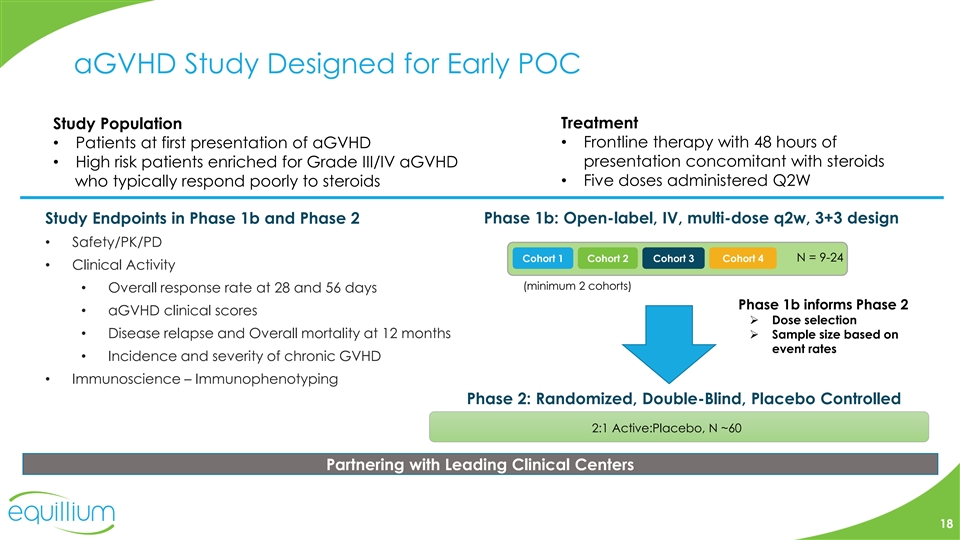
aGVHD Study Designed for Early POC Treatment Study Population • Patients at first presentation of aGVHD• Frontline therapy with 48 hours of • High risk patients enriched for Grade III/IV aGVHD presentation concomitant with steroids • Five doses administered Q2W who typically respond poorly to steroids Study Endpoints in Phase 1b and Phase 2 Phase 1b: Open-label, IV, multi-dose q2w, 3+3 design • Safety/PK/PD Cohort 1 Cohort 2 Cohort 3 Cohort 4 N = 9-24 • Clinical Activity (minimum 2 cohorts) • Overall response rate at 28 and 56 days Phase 1b informs Phase 2 • aGVHD clinical scores Ø Dose selection • Disease relapse and Overall mortality at 12 months Ø Sample size based on event rates • Incidence and severity of chronic GVHD • Immunoscience – Immunophenotyping Phase 2: Randomized, Double-Blind, Placebo Controlled 2:1 Active:Placebo, N ~60 Partnering with Leading Clinical Centers 18aGVHD Study Designed for Early POC Treatment Study Population • Patients at first presentation of aGVHD• Frontline therapy with 48 hours of • High risk patients enriched for Grade III/IV aGVHD presentation concomitant with steroids • Five doses administered Q2W who typically respond poorly to steroids Study Endpoints in Phase 1b and Phase 2 Phase 1b: Open-label, IV, multi-dose q2w, 3+3 design • Safety/PK/PD Cohort 1 Cohort 2 Cohort 3 Cohort 4 N = 9-24 • Clinical Activity (minimum 2 cohorts) • Overall response rate at 28 and 56 days Phase 1b informs Phase 2 • aGVHD clinical scores Ø Dose selection • Disease relapse and Overall mortality at 12 months Ø Sample size based on event rates • Incidence and severity of chronic GVHD • Immunoscience – Immunophenotyping Phase 2: Randomized, Double-Blind, Placebo Controlled 2:1 Active:Placebo, N ~60 Partnering with Leading Clinical Centers 18
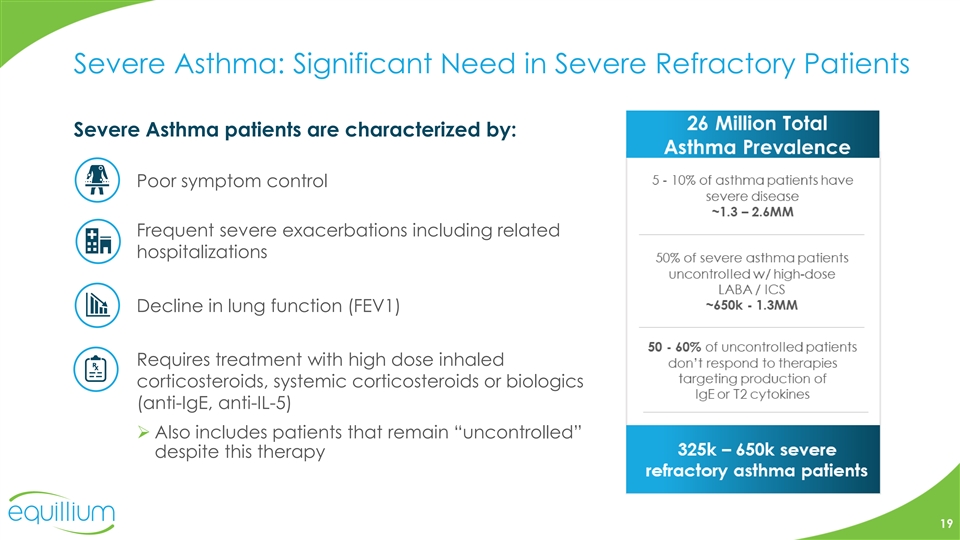
Severe Asthma: Significant Need in Severe Refractory Patients Severe Asthma patients are characterized by: Poor symptom control Frequent severe exacerbations including related hospitalizations Decline in lung function (FEV1) Requires treatment with high dose inhaled corticosteroids, systemic corticosteroids or biologics (anti-IgE, anti-IL-5) Ø Also includes patients that remain “uncontrolled” despite this therapy 19Severe Asthma: Significant Need in Severe Refractory Patients Severe Asthma patients are characterized by: Poor symptom control Frequent severe exacerbations including related hospitalizations Decline in lung function (FEV1) Requires treatment with high dose inhaled corticosteroids, systemic corticosteroids or biologics (anti-IgE, anti-IL-5) Ø Also includes patients that remain “uncontrolled” despite this therapy 19
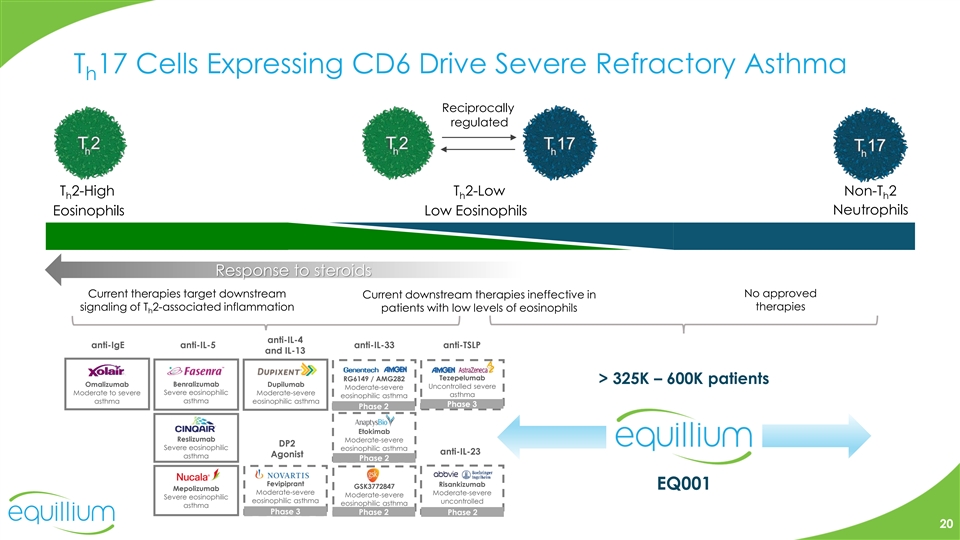
T 17 Cells Expressing CD6 Drive Severe Refractory Asthma h Reciprocally regulated T 2-High T 2-Low Non-T 2 h h h Eosinophils Low Eosinophils Neutrophils Response to steroids No approved Current therapies target downstream Current downstream therapies ineffective in therapies signaling of T 2-associated inflammation patients with low levels of eosinophils h anti-IL-4 anti-IgE anti-IL-5 anti-IL-33 anti-TSLP and IL-13 Tezepelumab RG6149 / AMG282 > 325K – 600K patients Omalizumab Benralizumab Dupilumab Uncontrolled severe Moderate-severe Moderate to severe Severe eosinophilic Moderate-severe asthma eosinophilic asthma asthma asthma eosinophilic asthma Phase 3 Phase 2 Etokimab Reslizumab Moderate-severe DP2 Severe eosinophilic eosinophilic asthma anti-IL-23 Agonist asthma Phase 2 Fevipiprant Risankizumab GSK3772847 EQ001 Mepolizumab Moderate-severe Moderate-severe Moderate-severe Severe eosinophilic eosinophilic asthma uncontrolled eosinophilic asthma asthma Phase 3 Phase 2 Phase 2 20T 17 Cells Expressing CD6 Drive Severe Refractory Asthma h Reciprocally regulated T 2-High T 2-Low Non-T 2 h h h Eosinophils Low Eosinophils Neutrophils Response to steroids No approved Current therapies target downstream Current downstream therapies ineffective in therapies signaling of T 2-associated inflammation patients with low levels of eosinophils h anti-IL-4 anti-IgE anti-IL-5 anti-IL-33 anti-TSLP and IL-13 Tezepelumab RG6149 / AMG282 > 325K – 600K patients Omalizumab Benralizumab Dupilumab Uncontrolled severe Moderate-severe Moderate to severe Severe eosinophilic Moderate-severe asthma eosinophilic asthma asthma asthma eosinophilic asthma Phase 3 Phase 2 Etokimab Reslizumab Moderate-severe DP2 Severe eosinophilic eosinophilic asthma anti-IL-23 Agonist asthma Phase 2 Fevipiprant Risankizumab GSK3772847 EQ001 Mepolizumab Moderate-severe Moderate-severe Moderate-severe Severe eosinophilic eosinophilic asthma uncontrolled eosinophilic asthma asthma Phase 3 Phase 2 Phase 2 20
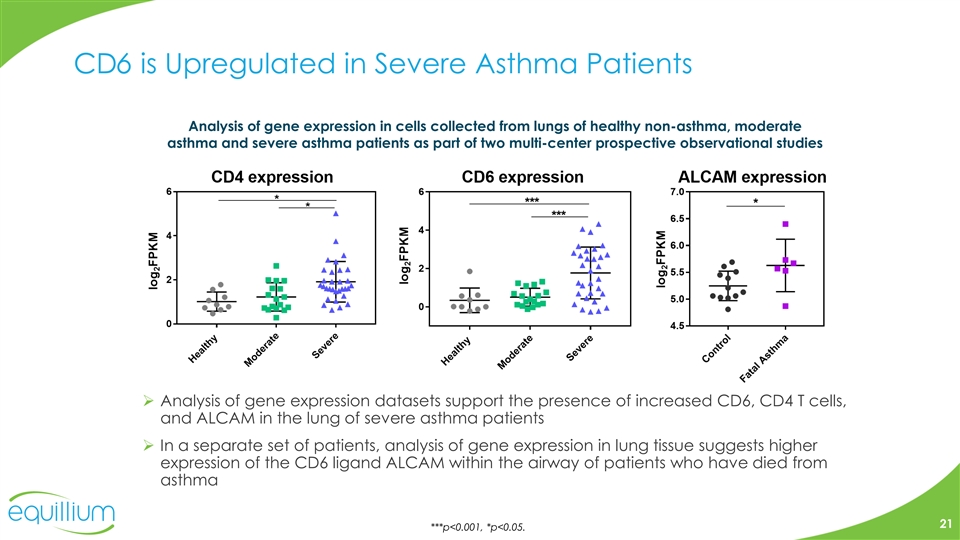
CD6 is Upregulated in Severe Asthma Patients Analysis of gene expression in cells collected from lungs of healthy non-asthma, moderate asthma and severe asthma patients as part of two multi-center prospective observational studies Ø Analysis of gene expression datasets support the presence of increased CD6, CD4 T cells, and ALCAM in the lung of severe asthma patients Ø In a separate set of patients, analysis of gene expression in lung tissue suggests higher expression of the CD6 ligand ALCAM within the airway of patients who have died from asthma 21 ***p<0.001, *p<0.05.CD6 is Upregulated in Severe Asthma Patients Analysis of gene expression in cells collected from lungs of healthy non-asthma, moderate asthma and severe asthma patients as part of two multi-center prospective observational studies Ø Analysis of gene expression datasets support the presence of increased CD6, CD4 T cells, and ALCAM in the lung of severe asthma patients Ø In a separate set of patients, analysis of gene expression in lung tissue suggests higher expression of the CD6 ligand ALCAM within the airway of patients who have died from asthma 21 ***p<0.001, *p<0.05.
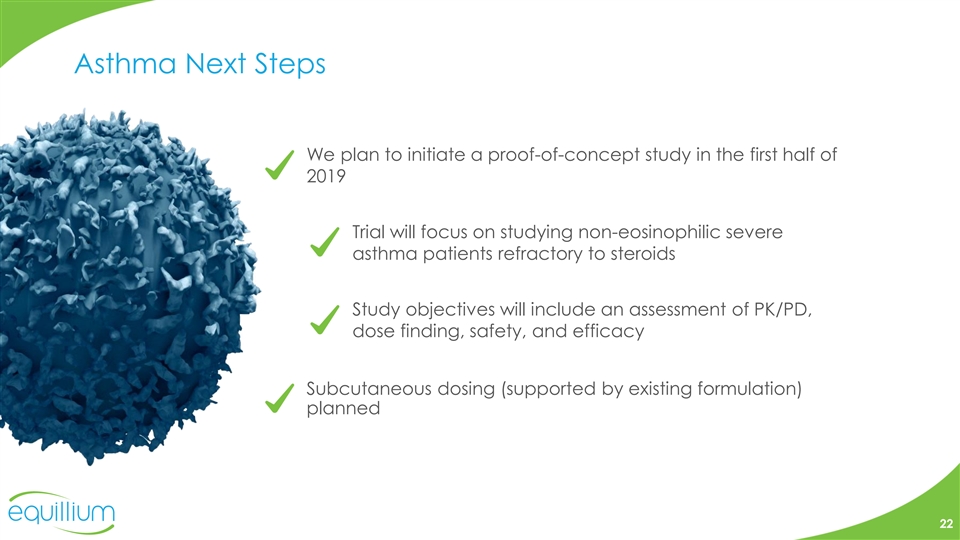
Asthma Next Steps We plan to initiate a proof-of-concept study in the first half of 2019 Trial will focus on studying non-eosinophilic severe asthma patients refractory to steroids Study objectives will include an assessment of PK/PD, dose finding, safety, and efficacy Subcutaneous dosing (supported by existing formulation) planned 22Asthma Next Steps We plan to initiate a proof-of-concept study in the first half of 2019 Trial will focus on studying non-eosinophilic severe asthma patients refractory to steroids Study objectives will include an assessment of PK/PD, dose finding, safety, and efficacy Subcutaneous dosing (supported by existing formulation) planned 22
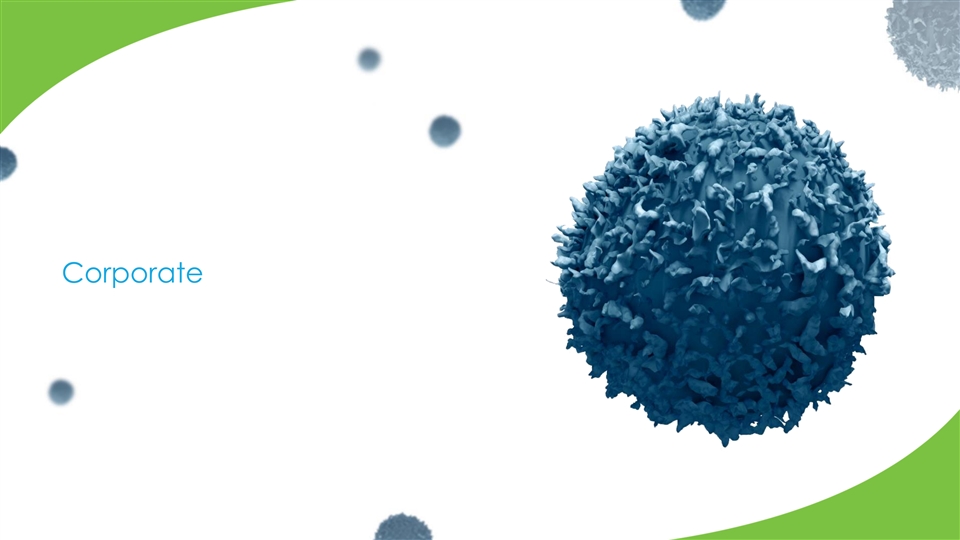
CorporateCorporate
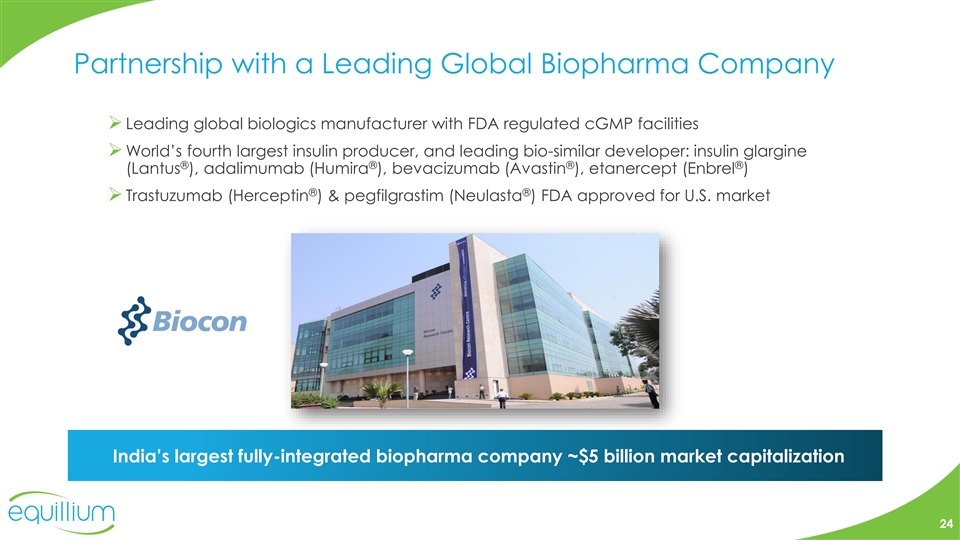
Partnership with a Leading Global Biopharma Company Ø Leading global biologics manufacturer with FDA regulated cGMP facilities Ø World’s fourth largest insulin producer, and leading bio-similar developer: insulin glargine ® ® ® ® (Lantus ), adalimumab (Humira ), bevacizumab (Avastin ), etanercept (Enbrel ) ® ® Ø Trastuzumab (Herceptin ) & pegfilgrastim (Neulasta ) FDA approved for U.S. market India’s largest fully-integrated biopharma company ~$5 billion market capitalization 24Partnership with a Leading Global Biopharma Company Ø Leading global biologics manufacturer with FDA regulated cGMP facilities Ø World’s fourth largest insulin producer, and leading bio-similar developer: insulin glargine ® ® ® ® (Lantus ), adalimumab (Humira ), bevacizumab (Avastin ), etanercept (Enbrel ) ® ® Ø Trastuzumab (Herceptin ) & pegfilgrastim (Neulasta ) FDA approved for U.S. market India’s largest fully-integrated biopharma company ~$5 billion market capitalization 24
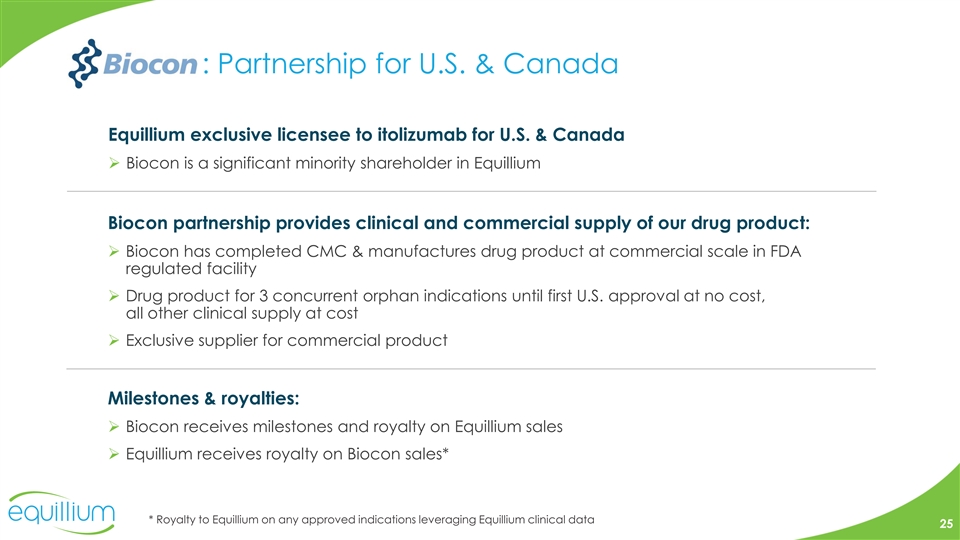
: Partnership for U.S. & Canada Equillium exclusive licensee to itolizumab for U.S. & Canada Ø Biocon is a significant minority shareholder in Equillium Biocon partnership provides clinical and commercial supply of our drug product: Ø Biocon has completed CMC & manufactures drug product at commercial scale in FDA regulated facility Ø Drug product for 3 concurrent orphan indications until first U.S. approval at no cost, all other clinical supply at cost Ø Exclusive supplier for commercial product Milestones & royalties: Ø Biocon receives milestones and royalty on Equillium sales Ø Equillium receives royalty on Biocon sales* * Royalty to Equillium on any approved indications leveraging Equillium clinical data 25: Partnership for U.S. & Canada Equillium exclusive licensee to itolizumab for U.S. & Canada Ø Biocon is a significant minority shareholder in Equillium Biocon partnership provides clinical and commercial supply of our drug product: Ø Biocon has completed CMC & manufactures drug product at commercial scale in FDA regulated facility Ø Drug product for 3 concurrent orphan indications until first U.S. approval at no cost, all other clinical supply at cost Ø Exclusive supplier for commercial product Milestones & royalties: Ø Biocon receives milestones and royalty on Equillium sales Ø Equillium receives royalty on Biocon sales* * Royalty to Equillium on any approved indications leveraging Equillium clinical data 25

Intellectual Property & Market Exclusivity Orphan Designation -7 years Projected FDA regulatory exclusivity Biologics Exclusivity If eligible, would be -12 years granted upon U.S. approval 2010 2020 2030 2040 Patent term 2005 2015 2025 2035 Method of Treating Severe Asthma Provisional Application (2039) U.S. Provisional Application • Method of treating severe asthma Patent term ~ 2039 Pending PCT Application (2037) Method of Treating Lupus • Method of treating lupus PCT Application Pending Applications (2030-2034) Patent term ~ 2037 • Formulation patent Method of Treating MS • Method of treating MS (High T 17) h U.S. Patent Application Granted US Patents (2028) Patent term ~ 2034 • Molecule’s sequence Method of Formulating • Method of treating: U.S. Patent Application – psoriasis Patent term ~ 2030 – multiple sclerosis Composition of Matter / Method of Treating – rheumatoid arthritis U.S. Patent No. 8,524,233 – transplant rejection Patent term ~ 2028 26Intellectual Property & Market Exclusivity Orphan Designation -7 years Projected FDA regulatory exclusivity Biologics Exclusivity If eligible, would be -12 years granted upon U.S. approval 2010 2020 2030 2040 Patent term 2005 2015 2025 2035 Method of Treating Severe Asthma Provisional Application (2039) U.S. Provisional Application • Method of treating severe asthma Patent term ~ 2039 Pending PCT Application (2037) Method of Treating Lupus • Method of treating lupus PCT Application Pending Applications (2030-2034) Patent term ~ 2037 • Formulation patent Method of Treating MS • Method of treating MS (High T 17) h U.S. Patent Application Granted US Patents (2028) Patent term ~ 2034 • Molecule’s sequence Method of Formulating • Method of treating: U.S. Patent Application – psoriasis Patent term ~ 2030 – multiple sclerosis Composition of Matter / Method of Treating – rheumatoid arthritis U.S. Patent No. 8,524,233 – transplant rejection Patent term ~ 2028 26

Accomplished Management Team Dan Bradbury Chairman & Chief Executive Officer Bruce Steel, CFA President & Chief Business Officer Steve Connelly, PhD Chief Scientific Officer Krishna Polu, MD Chief Medical Officer Jason Keyes Chief Financial Officer David Essayan, MD Head of Regulatory Affairs Christine Zedelmayer Vice-President of Operations Joel Rothman Vice-President of Development Randy Adams Vice-President of Commercial 27Accomplished Management Team Dan Bradbury Chairman & Chief Executive Officer Bruce Steel, CFA President & Chief Business Officer Steve Connelly, PhD Chief Scientific Officer Krishna Polu, MD Chief Medical Officer Jason Keyes Chief Financial Officer David Essayan, MD Head of Regulatory Affairs Christine Zedelmayer Vice-President of Operations Joel Rothman Vice-President of Development Randy Adams Vice-President of Commercial 27
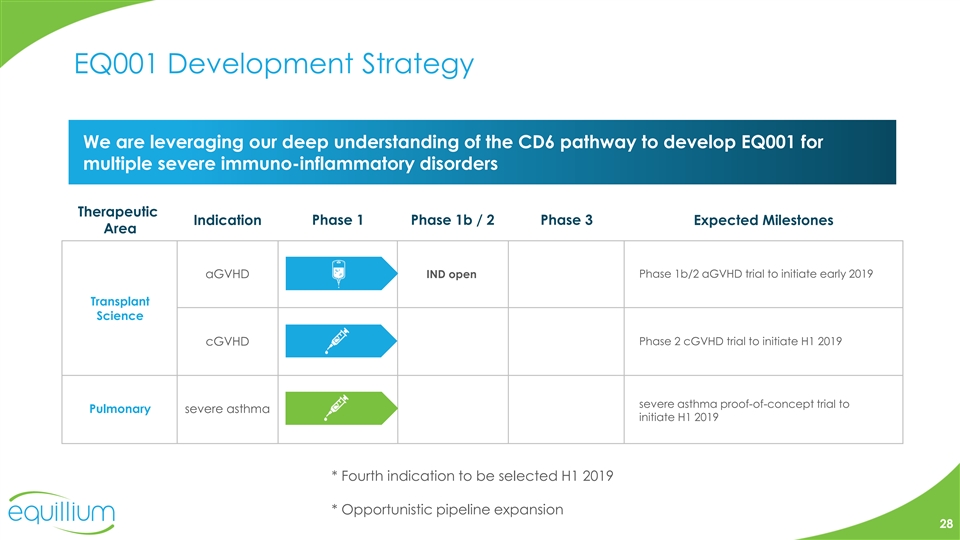
EQ001 Development Strategy We are leveraging our deep understanding of the CD6 pathway to develop EQ001 for multiple severe immuno-inflammatory disorders Therapeutic Indication Phase 1 Phase 1b / 2 Phase 3 Expected Milestones Area aGVHD IND open Phase 1b/2 aGVHD trial to initiate early 2019 Transplant Science Phase 2 cGVHD trial to initiate H1 2019 cGVHD severe asthma proof-of-concept trial to Pulmonary severe asthma initiate H1 2019 * Fourth indication to be selected H1 2019 * Opportunistic pipeline expansion 28EQ001 Development Strategy We are leveraging our deep understanding of the CD6 pathway to develop EQ001 for multiple severe immuno-inflammatory disorders Therapeutic Indication Phase 1 Phase 1b / 2 Phase 3 Expected Milestones Area aGVHD IND open Phase 1b/2 aGVHD trial to initiate early 2019 Transplant Science Phase 2 cGVHD trial to initiate H1 2019 cGVHD severe asthma proof-of-concept trial to Pulmonary severe asthma initiate H1 2019 * Fourth indication to be selected H1 2019 * Opportunistic pipeline expansion 28
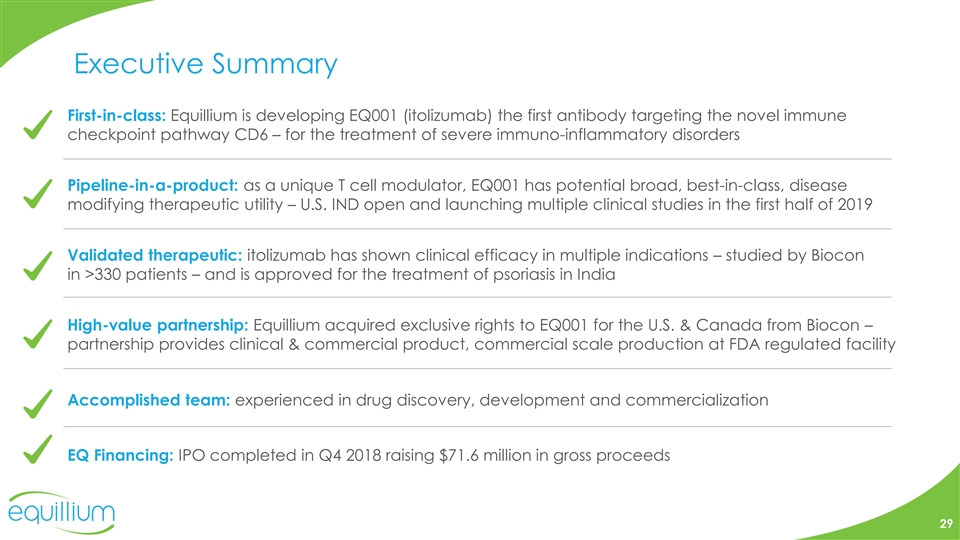
Executive Summary First-in-class: Equillium is developing EQ001 (itolizumab) the first antibody targeting the novel immune checkpoint pathway CD6 – for the treatment of severe immuno-inflammatory disorders Pipeline-in-a-product: as a unique T cell modulator, EQ001 has potential broad, best-in-class, disease modifying therapeutic utility – U.S. IND open and launching multiple clinical studies in the first half of 2019 Validated therapeutic: itolizumab has shown clinical efficacy in multiple indications – studied by Biocon in >330 patients – and is approved for the treatment of psoriasis in India High-value partnership: Equillium acquired exclusive rights to EQ001 for the U.S. & Canada from Biocon – partnership provides clinical & commercial product, commercial scale production at FDA regulated facility Accomplished team: experienced in drug discovery, development and commercialization EQ Financing: IPO completed in Q4 2018 raising $71.6 million in gross proceeds 29Executive Summary First-in-class: Equillium is developing EQ001 (itolizumab) the first antibody targeting the novel immune checkpoint pathway CD6 – for the treatment of severe immuno-inflammatory disorders Pipeline-in-a-product: as a unique T cell modulator, EQ001 has potential broad, best-in-class, disease modifying therapeutic utility – U.S. IND open and launching multiple clinical studies in the first half of 2019 Validated therapeutic: itolizumab has shown clinical efficacy in multiple indications – studied by Biocon in >330 patients – and is approved for the treatment of psoriasis in India High-value partnership: Equillium acquired exclusive rights to EQ001 for the U.S. & Canada from Biocon – partnership provides clinical & commercial product, commercial scale production at FDA regulated facility Accomplished team: experienced in drug discovery, development and commercialization EQ Financing: IPO completed in Q4 2018 raising $71.6 million in gross proceeds 29

Equillium, Inc. 2223 Avenida de la Playa / Suite 108 La Jolla, CA 92037 www.equilliumbio.comEquillium, Inc. 2223 Avenida de la Playa / Suite 108 La Jolla, CA 92037 www.equilliumbio.com
